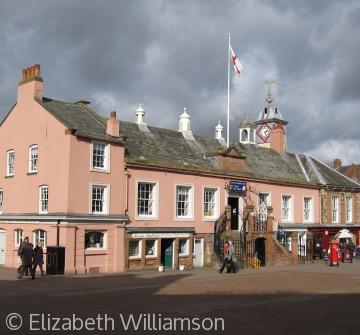Public Buildings
 Carlisle Town Hall, built in 1717 but altered since
Carlisle Town Hall, built in 1717 but altered sincePublic buildings form the landmarks of most towns and cities. Until the late 20th century, they were often the largest and grandest buildings, intended to be imposing in order to express the authority of church, state and local government. Each was designed for a particular purpose or combination of uses; for example the town hall, for ceremonial and government functions, was often combined with council offices where those functions were administered.
Before the late 17th century public buildings were built in local styles and with local materials and so shared the characteristics of other buildings in the area. Sometimes older buildings were adapted for new uses, a practice which continues today in small towns such as Ledbury. Greater central control of local activities made accommodation and style more standard. By the 19th century towns and cities invested large amounts of money and local pride in town halls, covered markets, libraries and museums, paying for eye-catching features such as towers and elaborate decoration, including coats of arms and symbols of local trades and industries.
In small towns public buildings often combined more than one function. Many had a meeting room, often used for collecting tolls or by ruling guild or town council, above an open market space, as can be seen at Newent in Gloucestershire and in the Oxfordshire towns of Burford and Henley. Individual craft guilds had meeting places which followed the pattern of domestic halls, with a high end for the ruling elite. Religious and charitable institutions and individual benefactors were responsible for almshouses, hospitals, schools and cultural institutes, which consequently expressed personal tastes and requirements.
County towns had been important for the administration of national justice since the Conquest. Their castles were eventually replaced or supplemented by purpose-built assize courts and gaols, and many handsome examples survive from the 18th and early 19th centuries. As a more complex system of national and local government, welfare and education developed, types of public building became more distinct and incorporated new ideas about how they should be designed. From the late 18th century prisons, hospitals and schools were influenced by theories about how best to control and improve moral character as well as physical conditions, and many were moved from traditional sites in town centres to the periphery. Twentieth-century public buildings are often designed to be informal, accessible and flexible while creating a striking presence in neighbourhood and town centre.
Other types of building used by the public – railway stations, banks, and hotels – were provided by commercial companies, who attracted and reassured customers by their substantial and well-designed premises. They too were planned to suit the function they housed, whether it be ballrooms, bedrooms and service quarters in a hotel, or counters, offices and the manager’s living accommodation in a bank.










